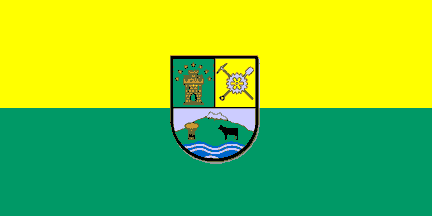
image by Jens Pattke, 29 October 2002

Last modified: 2014-05-17 by zoltán horváth
Keywords: pichincha | mejia |
Links: FOTW homepage |
search |
disclaimer and copyright |
write us |
mirrors

image by Jens Pattke, 29 October 2002
see also:
Based on image from <www.pichincha.gov.ec>
(defunct).
Falko Schmidt, 29 October 2002
The canton was formed on 23 July 1883. It is named after José
Mejía Lequerica Barrotieta (1775-1813), a lawyer born in Quito
who brought many ideas of the French Constitution of
1791 to the new Spanish Constitution. See "A Latin American
Spokesman in Napoleonic Spain: José Mejía Lequerica", by
Phlip L. Astuto, The Americas, 24:354-377 (1968).
The flag and coat of arms of Mejía are presented on the municipal
website.
The flag is horizontally divided yellow-green. "The yellow
stripe highlights the soil's resource in the arable lands, where
wheat and barley grow abundantly. The green stripe represents the
natural landscapes of the canton."
The coat of arms is described as follows: "Upper dexter
quarter: Vert, a castle or, representing the canton's capital,
surmonted by seven stars of the same symbolizing the seven rural
parishes of the canton. Upper sinister canton: Yellow, a cog
wheel with 16 cogs proper, representing the industrial potential.
A peak and a shovel proper crossed [per saltire], representing
the development of mining industry. Lower quarter: Azure, Mount
Rumiñahui vert [with a white, snowy top]. In dexter lower part,
a grain sheaf representing agriculture. In sinister lower part, a
cow sable representing cattle breeding. The whole over a wavy
stripe blue and argent representing the thermal and bathing
waters."
The capital of the canton is the town of Machichi, while the
seven rural parishes are Alóag, Aloasí, El Chaupí, Cutuglahua,
Tambillo, Uyumbicho and Manuel Cornero Astorga (Tandapi).
The flag can be seen behind the Mayor on a photograph available
on the municipal
website.
Ivan Sache, 20 October 2008
p-mej.jpg)
image from <www.pichincha.gov.ec>
(defunct), located by Falko Schmidt, 29 October 2002